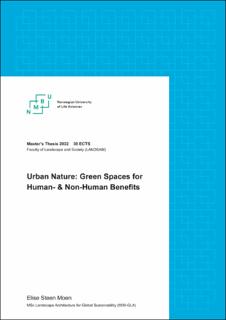| dc.description.abstract | Even before the rise of environmental concerns, people have been fascinated by nature. The wilderness has wildly been romanticized as a place of inherent value. In the meantime, our urban centers have kept growing and sprawling into surrounding landscapes at the expense of natural areas and resources, depleting the earth’s systems. With the current (frightening) trends in climate change, affecting biodiversity, and rising extreme weather events, there is now time for urgent change in the way we view and use nature.
Urban Nature is a term that encompasses both ends of the nature-culture duality. The urban and nature. It is nature that we surround ourselves with in our everyday lives. Urban Nature, at its best, is abundant, close to our homes, and offers recreational values and resilience to extreme weather. With urbanization and its rapid growth, urban landscapes get fragmented, effectively threatening local biodiversity and making urban nature areas less accessible and scarcer.
The Objective of the thesis is to explore the topic of urban nature and how urban nature quality can be promoted through landscape design, also in the context of urbanization in Oslo’s most extensive transformation area, Hovinbyen.
The thesis investigates a neighborhood at the edge of Hovinbyen, Etterstadsletta, as an area to rethink with the framework of creating a more vital link between urban neighborhood and nature, promoting urban nature focusing on the species hedgehog (Erinaceus europaeus) and red squirrels (Sciurus vulgaris) as well as us humans, Homo sapiens.
By acknowledging that landscapes are heavily affected by culture, we also admit that humans have the means to change landscapes for the better. What is allowed to thrive and what is not is a decision often deliberately or accidentally made by humans.
The proposed design is not natural, but it is designed with lessons learned from nature, inspired by nature, to give people a feeling of nature and its valuable benefits. The design opens for instances of non-design, with areas that allow for spontaneous vegetation to settle and that will not necessarily get managed other than by interactions with human and non-human movement and activities. This can hopefully partake in creating an ecosystem unique to the place, allowing for humans and other local species to cohabit in the neighborhood. | en_US |

